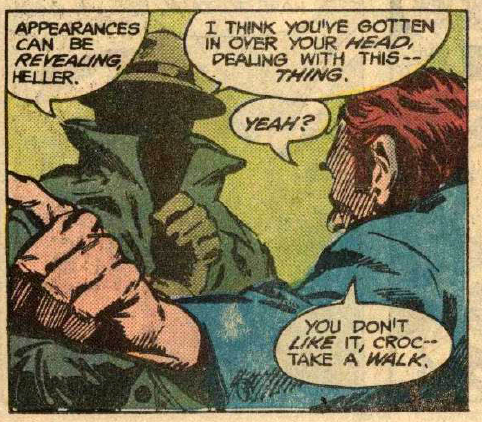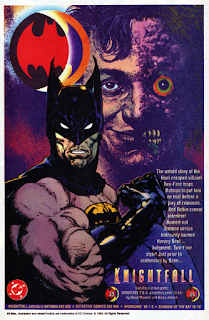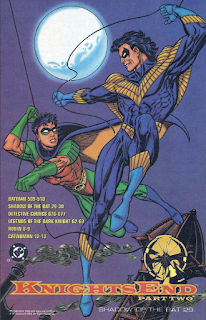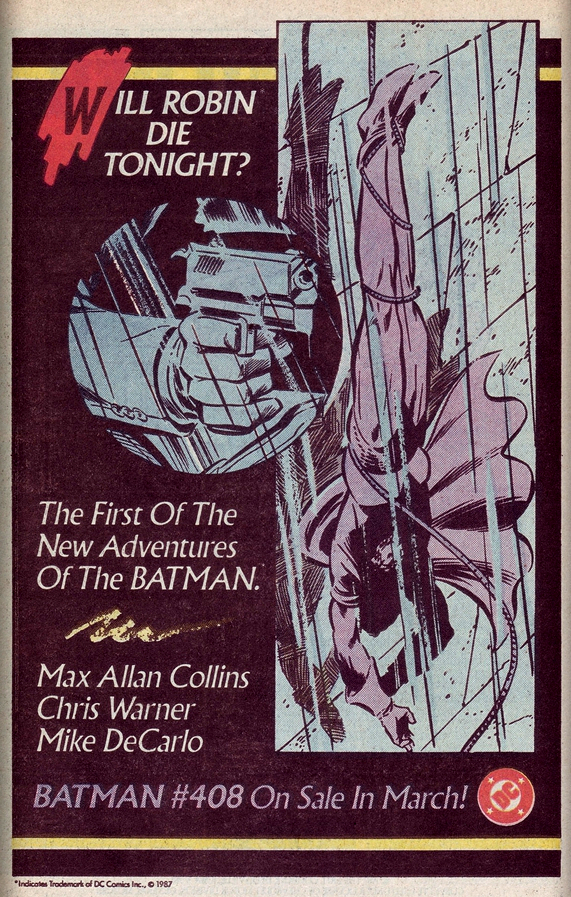Know your Suicide Squad: Killer Croc
[Killer Croc has been heavily active in DCU Continuity for the past two decades, but for the sake of keeping 'on theme' with this webzine, we're only going to focus on his 80s appearances all the way up to the very early 90s. - editor]
Created by Gerry Conway and Gene Colan, Killer Croc first appears in Detective Comics #523 (1983). He's a slim gangster in a trench coat and fedora who goes by the name of 'Croc' and spends most of his time skulking in the background. I'm going to set the scene here: it's the early 80s and Gotham City gangsters Rupert Thorne and Tony Defalco have been dethroned, so there's a bit of a power-vacuum within the Gotham Underworld. Dick Grayson is still Robin, but he's an active member of the Teen Titans, and his relationship with Bruce Wayne is starting to show some strain. Bruce seems to be getting a bit more tense and is currently juggling two women in his life: Selina Kyle and Vicki Vale. On the editorial side, Len Wein had recently started editing both Batman and Detective Comics and intended on merging the continuities of all Batman titles (i.e. Batman, Detective Comics, Brave and the Bold, and World's Finest) to keep everything feeling like it's occurring in the same universe.
In his third appearance (Detective Comics #524), Croc's fedora gets knocked off in an altercation and we get the first full-view of his scaly face:
 |
| Despite the scales, he is still rather 'human-looking' |
Croc was first presented as a 'smooth operator' making moves to take control of Gotham City's underworld, and his first major murder within Gotham City was performed using a long-range sniper rifle. Croc's debut appearance had him involved in a six-issue story arc running between Batman #357 - 359 (1983) and Detective Comics #524 - 526 (1983). [It wasn't unusual for Batman stories to continue from one title to the next.] It's kind of interesting to note the progression of Croc going from a tactical criminal mastermind to a berzerker hand-to-hand combatant within these six issues. At his worst, he's an experienced alligator wrestler who is really trying hard to break Batman's back - he's not trying to eat people, yet. At least one reader picked up on this rapid evolution of the character and wrote in to comment on it. Wein replied with "We got the impression that Croc's dual nature was somehow tied in to his reptilian appearance. Half of the time he was clever, manipulative, a real snake. But still being half human, he was given to all-too-human fits of rage. Made sense to us!" [It should probably also be noted that Killer Croc only goes berserk after Batman infiltrates his 'home'. More on this later. -J]
Killer Croc's pre-Crisis origin is summarized in Batman #359 (1983): he was born with a hideous skin disease in a lower-income area of town and had a dead-beat aunt as his only care-taker. Croc spent most of his youth in and out of prison, and kills another inmate when he's a young adult. After spending an additional 18 years behind bars he gets paroled and joins the carnival as an alligator wrestler. Some time after joining the carnival, he decides to leaves and start getting his revenge on those who did him wrong in the past - ultimately deciding to take over the Gotham Underworld. In so many panels, Conway depicts Killer Croc as a "victim" of the system - perhaps even a villain to sympathize with. Any sympathy the reader may acquire for Croc pretty much goes out the window after the events of the next few issues.
Detective Comics #526 (1983) was Gerry Conway's last issue in this Batman saga before he went over to start working on The Fury of the Firestorm. Doug Moench would replace Conway as regular writer for Batman and Detective Comics. Conway's run ended with Killer Croc meeting with the rest of the Batman Rogues, and the addition of a new Batman Family character.
The reason why Killer Croc's first recognized appearance (Batman #357, 1983) will cost you a little more on the back issue market is because Batman #357 is also the first appearance of the pre-Crisis Jason Todd. No, not that fiesty dark-haired scamp who stole our hearts (and the Batmobile's tires) during Max Allan Collins' Batman run, we're talking about this guy:
You see, in pre-Crisis history, Killer Croc was instrumental in Jason Todd becoming Batman's new Robin because Killer Croc kills Todd's parents. Prior to Crisis on Infinite Earths, this was Killer Croc's greatest claim to fame. This was taken away from Croc after the Jason Todd origin was rebooted. Todd's father was still killed by a Bat-Villain, but this time it was Two-Face instead of Killer Croc (Batman #410, 1987). Why was Croc bumped for Harvey Dent? Batman: The New Adventures starts at Batman #408 (1987) immediately following Batman: Year One. Is it possible that DC editorial wanted to re-introduce Harvey Dent/Two-Face as quickly as possible in the "new Batman reboot" in order to establish him as an important fixture in Bat-lore? Writer Max Allan Collins reached out to us and told us that he was instructed to "make Jason Todd wholly independent from the previous version". The Two-Face arc, which Collins' mentioned that he would've resolved very differently, was his own idea. DC editorial pretty much gave Collins a carte-blanche to re-imagine Jason Todd's origin any way he saw fit, so there was no intentional effort on DC's behalf to omit Croc from Jason Todd's history.
If you get the sense that I'm focusing a little too intently on Killer Croc's first six-issue story arc from 1983, well... that's because I am. Croc didn't do very much for the rest of the 80s.
Killer Croc's next appearance was in 1986's Batman #400. This anniversary issue was a superb self-contained story that featured all the major Bat-Villains and boasted an all-star cast of artistic talent. A few sentences cannot adequately explain what a visual treat this issue is, so we'll need to save that for another day. Instead, we'll just mention that all of the Bat-Villains are freed from their various methods of incarceration and Killer Croc gets another shot at Batman. Killer Croc is still a vengeance-fueled monster, albeit a human-sized one. Truthfully, he looks like a professional body builder with a horrible skin condition. At some point, Croc has the audacity to break into Wayne Manor and attack Alfred. (If you're seeing a lot of parallels with 1993's Knightfall, please note that Doug Moench wrote both this issue and was also part of the Knightfall writing team.) For anyone keeping track, this issue occurs after Crisis on Infinite Earths, but before the 1986 Batman reboot. The pre-Crisis Jason Todd (who now suspiciously looks like a dead-wringer for the Dick Grayson Robin [ex: black hair, wears a traditional Robin costume]) appears in this issue and Batman goes to great efforts to keep him away from Croc. The reader is briefly reminded that Croc killed Jason's parents and, in a struggle, Batman ends up defeating Croc with a gas pellet from his utility belt. [While doing research for this article, I discovered that Detective Comic #566 and Batman #400 are inter-connected. How cool is that? -J]
Croc's first post-Batman reboot appearance would be brief [an entire 3 pages] in Swamp Thing v2 #66 (1987) written by Rick Veitch. By this point, he's more or less regressed to a reptile state and has trouble stringing together sentences with proper nouns and verbs. Still human-sized, but unbelievably ferocious, Batman ends up subduing him with nerve gas. It's alluded that Croc is now crippled due to Batman's actions. Croc and Batman's very brief and abrupt appearance (they literally come in crashing through a window) served as an 'action break' in an otherwise very dialogue-heavy story about Swamp Thing and Abby working out relationship issues.
Secret Origins #23 (1988), also written by Veitch, is a recap on the origin of Dr. Jason Woodrue - aka the Floronic Man - told from the point of view of a wheelchair-bound Killer Croc. The Floronic Man, who in the past few years has had strong ties to Swamp Thing thanks to Alan Moore, was slated for bigger things in 1988 thanks to the Millennium cross-over event and his inclusion in 1988's The New Guardians series - so clearly, a recap was in order to re-familiarize readers with the character. Throughout Killer Croc's narrative, we realize he's a lot more intelligent/cognitive than he appears and by then end of the story it is revealed that he has recovered from his nerve gas induced paralysis (it's hinted that's it's due to his 'reptilian' abilities). I'd like to think that this was Veitch's way of tying up any loose ends for both Croc and Woodrue before letting go of the characters for new creative teams to use.
Killer Croc's next appearance would be in 1991's Batman #471 written by Alan Grant and edited by Dennis O'Neil. Grant decided to portray Croc in a sympathetic light for this issue - we get a Croc who just wants to belong and feel like he has a home, so he takes up in the sewers of Gotham City with a group of homeless people. We get a quick recap of his back-story in this issue: this includes a lot of electroshock therapy, a serious hate for Batman, and a brief mention that he never knew his parents and was raised by a neglectful aunt - of course there's no mention of Croc killing Todd's parents, because that's been retconned. Grant very craftily kept most of Croc's pre-Crisis origin intact while giving us a bit of rationale explaining why Croc acted the way he did. This was one of Grant's signature story-telling devices - to provide a 'human element' to a story or character. The issue ends with Croc seemingly 'sacrificing' himself to save his adopted family from an environmental disaster and Batman looking like a heartless chump who just won't leave Croc alone. Croc's search for 'a home' retroactively syncs with his debut where he goes into hysterics at Batman for breaking into his private residence [way back in the Croc's first 1983 story arc].
While Killer Croc no longer being associated with the origin of the new Robin may have diminished his importance as a Bat-Villain, it made him easier to sympathize with - especially since he'd been so sparsely used in the DCU throughout the mid-to-late 80s and early 90s. To a new era of readers brought in by 1989's Batmania, he was still a relatively new character that only Batman fans who had been following the series for the last decade may remember. That was all about to change in 1992.
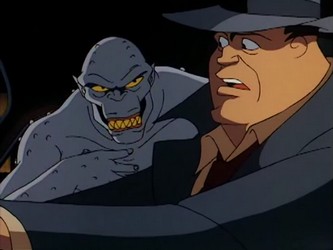 |
| Batman: The Animated Series, episode 23 (1992) "Vendetta" |
Batman: The Animated Series, with it's neo-noir atmosphere and intelligent storytelling, really opened up the Batman universe to a new fan-base of television watchers in 1992. Despite being a long-time Batman fan with a functional knowledge of Batman's rogues gallery (mainly via Super Friends and The Adventures of Batman cartoons), this was my first exposure to Killer Croc. In the animated universe, Killer Croc goes by the name of 'Morgan' (not 'Waylon Jones') and seems to have some sort of history with Detective Harvey Bullock. His origin is also slightly altered as he's apparently had a career as a professional wrestler prior to becoming a criminal. I'm not going to dwell too much on his Batman: TAS appearances, but the show was a fantastic vehicle for introducing previously forgotten Bat-Villains and making them relevant again.
The last big Killer Croc appearance we'll cover is this installment will be his inclusion in the Knightfall event. Quite possibly thanks to his Batman: TAS appearance, Croc had more than a bit part in this 1993 event — first appearing in a few Knightfall 'prologue' issues (Batman #489 & #491) and then in an entire chapter (Detective Comics #660). Knightfall was THE Batman comic book event of the early 90s and spiked a renewed interest in Batman-related characters among comic book collectors everywhere [not just the readers/collectors, but the speculators, too].
 |
| Detective Comics #660 (1993). cover by Sam Keith |
Readers hailed #660 as one of the best appearances of Killer Croc in nearly a decade, demonstrating just how dangerous of a Bat-Villain he had the potential to be. Coincidentally, Detective Comics #660 was Croc's most reptilian appearance in this list of appearances. It would seem that as time goes by his appearance progressively becomes more and more crocodile-like (this is evidenced by his new 52 appearances with his elongated crocodile-like snout and gigantic hulking frame).
 |
| Killer Croc in Detective Comics #660 (1993) |
With the exception of Bane and Clayface (and maybe even Man-Bat), Killer Croc holds the distinction of being one of the few Bat-Villains who can physically overpower Batman in physical combat. I've always found Batman's villains to be more interesting than Batman himself. While not my favorite Bat-Villain (that honor would go to the Penguin), Killer Croc always stood out as being a green scaly monster among a group of relatively normal-looking people in costumes. So, suffice to say, his later evolution doesn't feel like a 'realistic threat' but more of a 'fantastic creation' that brought a horror/sci-fi feel to the Batman mythos [to be fair, Clayface, Solomon Grundy and Gentleman Ghost made me feel the same way]. What was Conway's 'grand plan' for Killer Croc, you wonder? Well...
In a 2009 interview with Gerry Conway on Cary's Comics Craze, Cary Ashby spoke with Conway about Croc's success:
“It’s a big surprise to me,” he said about Croc becoming more prominent in Batman’s Rogues Gallery of Villains since his first appearance in DETECTIVE COMICS No. 523 (dated Feb. 1983). “It was a surprise to everybody.”
Conway considers Croc “a good foil for Batman,” because Batman is intelligent while “Killer Croc is brutality and straightforward violence.”
“A lot of Batman’s Rogues Gallery is clever. He’s not clever,” he said. “It gave them (the Batman: The Animated Series creative team) a neat way to get into the underground.”
This is as far as we're going to go regarding the history of Killer Croc, but we have more articles about the Suicide Squad if you're so inclined:
- Who is El Diablo and why is he in the NEW Suicide Squad film?
- Know your Suicide Squad: The Enchantress
- Task Force X podcast
- Jason Brown reviews the Suicide Squad

